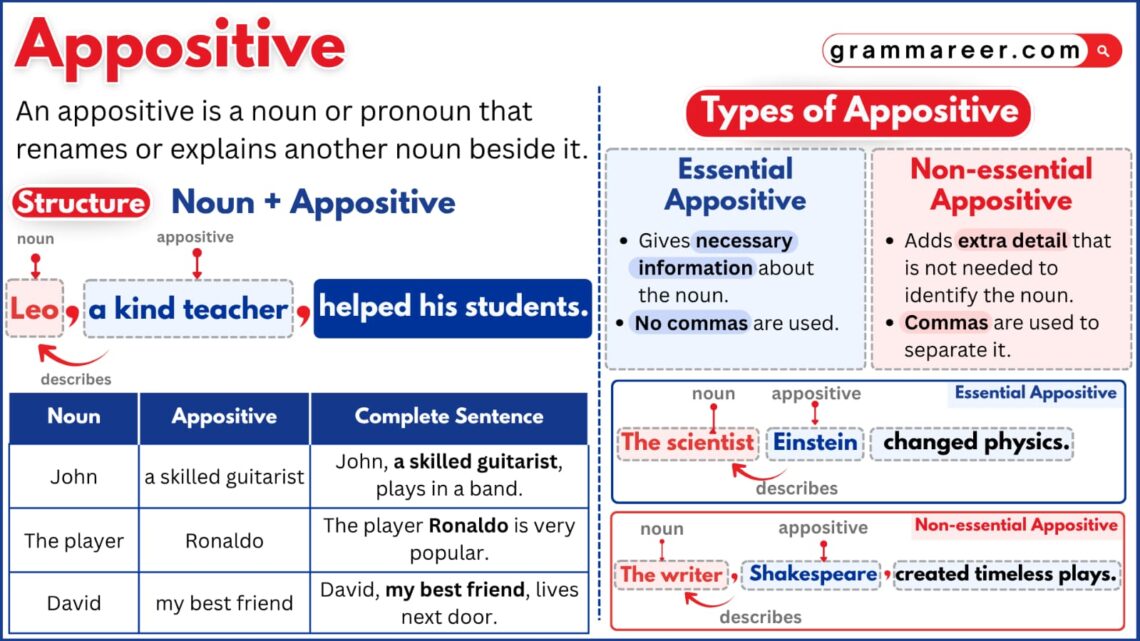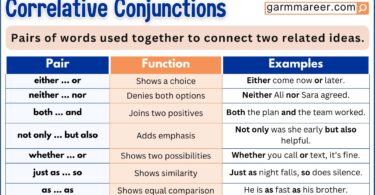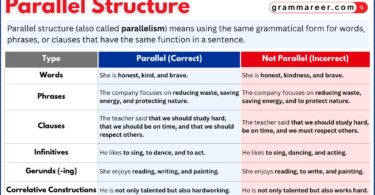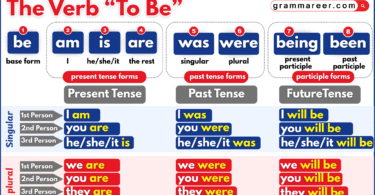Have you ever seen a sentence that adds a little extra info about something almost like a mini explanation right next to a noun? That’s what we call an appositive.
The word appositive actually comes from an old term meaning “to place side by side.” In grammar, it’s just a way to add more detail to a noun without starting a whole new sentence. Sometimes we use commas around appositives, and sometimes we don’t. It depends on whether the information is extra or essential to the meaning of the sentence.
In this article, we’ll learn what appositives are, how they work, and how you can use them to make your writing clearer and more engaging.
Table of Contents
What Are Appositives and Appositive Phrases?
An appositive is a word or group of words that gives more information about a noun right next to it. It helps identify, explain, or describe that noun in a clearer way.For example, you might say something like my friend Ali is learning guitar. Here, Ali tells us who my friend is. That’s an appositive.
When the appositive includes extra details or modifiers like adjectives or phrases, we call it an appositive phrase. It works the same way but gives a fuller picture.
In English, appositives usually come right after the noun they describe, but sometimes they can appear before it too. They make writing sound more natural, detailed, and interesting without adding extra sentences.
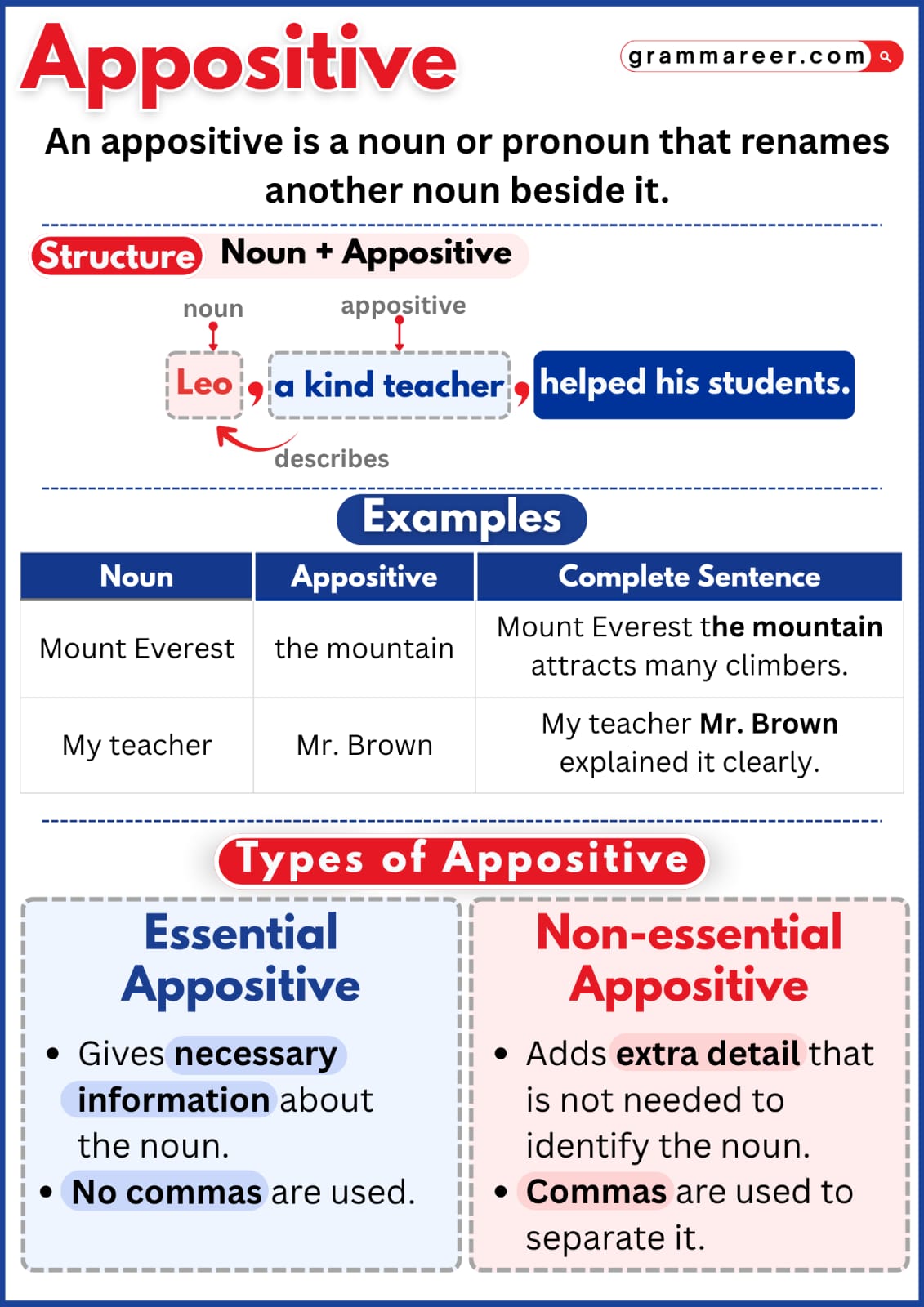
How to Use Appositives?
We use appositives to give more information about a noun in a sentence. They help make the meaning clearer or add extra detail about the person or thing being mentioned. To use an appositive correctly, it should always be placed right next to the noun it explains so the sentence sounds natural and easy to understand.
Example:
- Her brother Ali loves cricket.
- Here, Ali is the appositive because it tells who her brother is.
Appositives can be short or long, depending on how much information is added.
Example:
- Her dog, a golden retriever with soft fur, is very playful.
- In this example, the phrase a golden retriever with soft fur gives more detail about her dog.
Commas also play an important role when using appositives. If the appositive gives extra, non-essential information, commas should be used.
Example:
- Her teacher, Mr. Khan, is very kind.
- The name Mr. Khan adds extra information, so it is separated by commas.
But if the appositive is necessary to identify the noun, commas should not be used.
Example:
- Her friend Sara helped her with homework.
- Here, Sara specifies which friend, so no commas are needed.
Commas and Appositives
When we use appositives in sentences, commas play an important role in keeping our writing clear.
Most appositives are nonrestrictive, meaning they add extra information that isn’t needed to identify the noun. In such cases, use commas to separate the appositive from the rest of the sentence. If the appositive is in the middle, place commas on both sides. If it’s at the end, use one comma before it.
Correct comma use shows that the appositive is extra detail, not part of the main idea.
Using Nonrestrictive Appositives
A nonrestrictive appositive gives extra information about a noun, but it isn’t needed to understand the main idea of the sentence. You can remove it, and the sentence will still make perfect sense.
For Example:
| Correct ✅ | Incorrect ❌ |
| • Emma, my best friend, loves baking. (The phrase my best friend adds extra information about Emma, so it’s set off with commas.) | • Emma my best friend loves baking. (This sentence misses the commas, which makes it unclear and grammatically incorrect.) |
Another example:
| Correct ✅ | Incorrect ❌ |
| • Our teacher, Mr. Khan, explained the topic clearly. (The appositive Mr. Khan gives extra detail about our teacher.) | • Our teacher Mr. Khan explained the topic clearly. (Without commas, it sounds like Mr. Khan is essential information, but it’s actually extra.) |
You can also use parentheses or an em dash instead of commas if you want to give your sentence a slightly different tone.
Using Essential Appositives
Sometimes the information in an appositive is essential to identify the noun it describes. In that case, we don’t use commas.
An essential appositive helps make the meaning of a sentence clear. If you remove it, the sentence might become confusing or incomplete.
For Example:
| Correct ✅ | Incorrect ❌ |
| • My friend Sara is moving abroad. (The name Sara tells us which friend. It’s essential, so no commas are needed.) | • My friend, Sara, is moving abroad. (Adding commas here is wrong because it makes it sound like you have only one friend named Sara. |
Another Example:
| Correct ✅ | Incorrect ❌ |
| •The poet Robert Frost wrote “The Road Not Taken.” (Robert Frost is necessary to identify which poet you mean.) | • The poet, Robert Frost, wrote “The Road Not Taken.” (The commas make it sound like there’s only one poet, which changes the meaning.) |
Here, you can also use parentheses or an em dash instead of commas if you want a different tone, but it depends on how formal or casual you want your writing to sound.
Punctuation of Appositives
When it comes to punctuation, appositives follow different rules depending on whether they are essential (restrictive) or nonessential (nonrestrictive).
The rule is actually quite simple:
- Essential appositives don’t need commas.
- Nonessential appositives are separated by commas or sometimes parentheses.
Let’s look at how this works.
| ✅ Essential: | ✅ Nonessential: |
| •The detective Sherlock Holmes solved many cases. (Sherlock Holmes is needed to identify which detective.) | • The anteaters were looking for ants, their favorite snack. (Their favorite snack just adds extra information.) |
In formal writing, commas are more common, but you can also use parentheses if you want a softer, more casual tone:
- The anteaters were looking for ants (their favorite snack).
Commas or parentheses show that the extra information can be removed without changing the main meaning of the sentence. Still, it’s nice to keep it because it adds a little more detail.
Appositives vs. Subjects and Objects
Here’s something important to keep in mind: appositives don’t work as the subject or object of a sentence. They just give extra information about a noun. The subject or object decides the grammar, not the appositive.
For example:
- My friends, the best cooks in town, are planning a dinner tonight.
- Here, friends is the real subject, so the verb are matches it. The phrase the best cooks in town is just giving more detail about who the friends are—it doesn’t change the grammar of the sentence.
Examples of Appositive
- My brother, a college student, loves playing guitar.
- The sun, our nearest star, gives us light and warmth.
- Lisa, my best friend, is an excellent painter.
- The car, a sleek black sedan, belongs to my dad.
- Our teacher, Mr. Brown, always tells funny stories.
- The book, a thrilling mystery, kept me up all night.
- Chocolate, my biggest weakness, makes me happy.
- His dog, a golden retriever, loves chasing butterflies.
- The museum, a popular tourist spot, closes at six.
- Mount Everest, the tallest mountain in the world, attracts many climbers.
- My phone, an old model, still works perfectly.
- The restaurant, famous for its pasta, is always crowded.
- Emma, the team captain, encouraged everyone to keep trying.
- The beach, a peaceful place, helps me relax.
- London, the capital of England, is full of history.
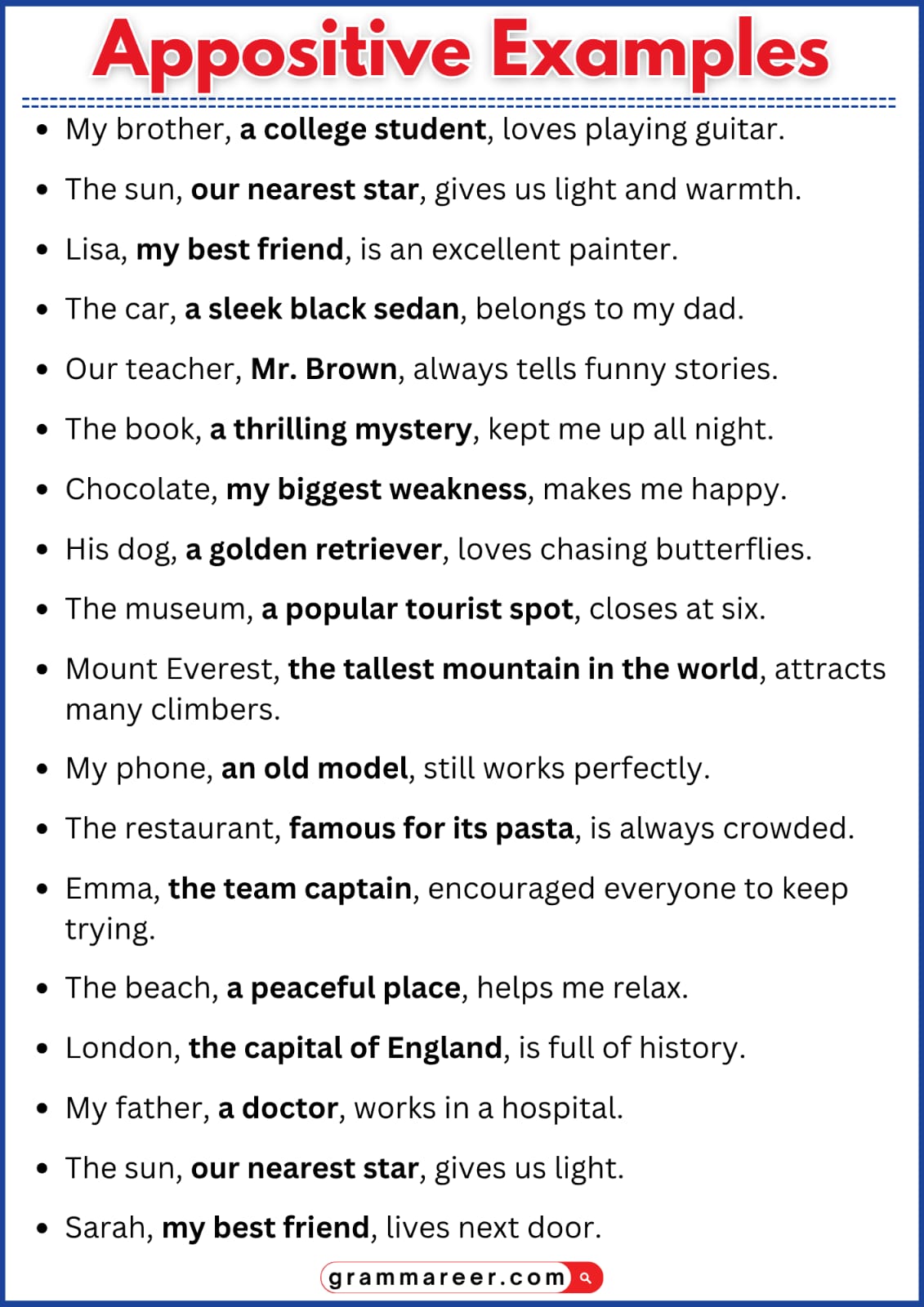
FAQs about Appositive
An appositive is a word that gives a little extra information about another noun right next to it. It helps make your sentence clearer or more interesting.
• For example, in My friend John is learning guitar, the word John tells us who my friend is and that’s an appositive.
An appositive is a noun placed beside another noun to rename or explain it. It doesn’t start a new sentence, it just adds a quick detail.
Sure! Here are a few easy examples:
• My brother, a college student, loves playing guitar.
• The sun, our nearest star, gives us light and warmth.
• Lisa, my best friend, is an excellent painter.
• The car, a red sports coupe, sped down the highway.
• Mount Everest, the tallest mountain in the world, attracts many climbers.
You May Also Like

